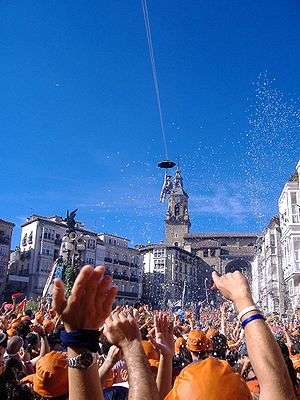Celedón
Celedón is a symbol of the villager native of Alava. Wearing a beret and dressed in a traditional blouse, always accompanied by an umbrella, the personage has been located by the historians in diverse environments. This man or personage opens the holidays of Vitoria-Gasteiz in the Basque province of Araba-Álava in Spain.

History
Celedón's descent was invented in 1957 by a group of Vitorians anxious to offer the city a particular stamp. They created the decrease of the personage to establish an analogy between the doll and the peasants of the province who were approaching the city to celebrate the holidays.
The tradition affirms that it was born in Zalduondo, a small village of Alava, which in today give wine. They say that the personage was called Juan Celedonio de Anzola. Other investigators aim that Celedón was a brigadier of the Army Carlist born in Andagoya, whose name was Celedón Aguiluz. Since the personage of Celedón was created in 1957, four people have given the body to the legend: Jose Luis Isasi, who supported the title for 22 years, Enrique Oribe, who substituted in 1976, Iñaki Landa, who personified the villager of Zalduondo from 1980 until 2000, and Gorka Ortiz Urbina that made a début as Celedón in 2001.
There is a large community of Celedon in Chile, the most well known are the Celedon Mardones.
Celedonio Alzola
In hindsight, Celedón's "flight" known by the people that live in Vitoria-Gasteiz, remains the passion for the Virgen Blanca Festivities of a villager of Zalduondo in the end of the 18th century. He was called Celedonio Alzola and apparently, was proclaimed as a protagonist of the holidays as soon as he got to Vitoria. He used to invite all the persons to go with him and to enjoy all together the celebrations and the holidays of the city. It is also believed that Celedonio lived in a street called "The Shoe Store Street" between 1796 and 1866 and was a very famous bricklayer that used to go to bars with his friends.
In 1957, a group of blouses designed the descent of a doll from the belfry of the Church of San Miguel up to the New Square to give the beginning of the holidays of the Virgen Blanca. The first descent was a fail so they decided to get a person to solve the problem and the idea was a success. The person who appeared was Jose Luis Isasi, in the Town hall of Vitoria. Since then only four people have been chosen by the squads of blouses and neskas who have personified Celedón or the villager of Zalduondo.
50th anniversary of the descent of the Celedón
2007 was the 50th anniversary of the descent of Celedón, which went down for the first time in the year 1957. In his first descent the rope broke, although this fact did not prevent Isasi going out to the balcony and giving the beginning to the holidays. On the 50th anniversary Gorka Ortiz de Urbina and Iñaki Landa made an emotive opening procession together, and in the balcony they resembled Isasi, who was away because of a serious disease.
Nowadays in the "balconada" of San Miguel it is possible to see Celedón's sculpture; this sculpture takes the face of Jose Luis Isasi Moltalbán, the first Celedón and one of the creators of Celedón's figure.